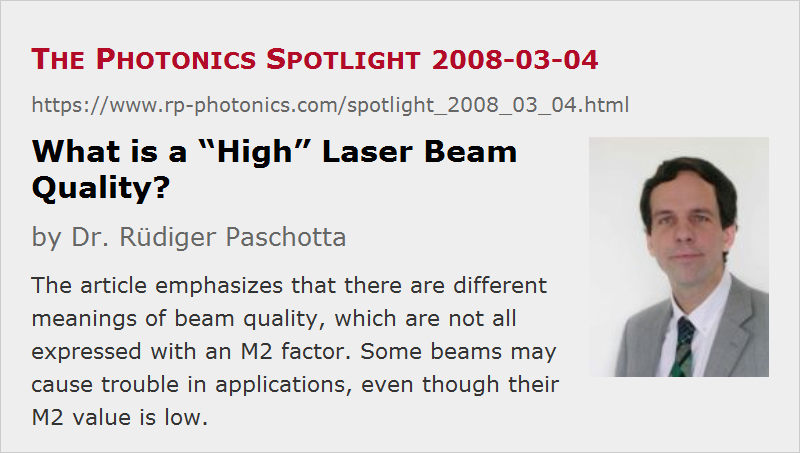What is a “High” Laser Beam Quality?
Posted on 2008-03-04 as a part of the Photonics Spotlight (available as e-mail newsletter!)
Permanent link: https://www.rp-photonics.com/spotlight_2008_03_04.html
Author: Dr. Rüdiger Paschotta, RP Photonics Consulting GmbH
Abstract: The article emphasizes that there are different meanings of beam quality, which are not all expressed with an M2 factor. Some beams may cause trouble in applications, even though their M2 value is low.

Ref.: encyclopedia articles on beam quality and broad-area laser diodes
The beam quality of a laser beam is commonly characterized with the beam parameter product or the M2 factor. However, a beam which looks good in terms of these quantities may nevertheless create a real mess in an application.
As an example, it can happen that the emission pattern of a broad-area laser diode has a complicated shape, even though the M2 factor is not that large. Even worse, the detailed shape can depend on the pumping conditions. If such a laser diode is used for pumping a solid-state laser (→ diode-pumped lasers), it induces a complicated pattern of thermal lensing in the laser crystal, where changes in the pump power lead to a change of the focal length and possibly also to a beam deflection, if the center of the pump beam also moves. All these effects may not matter that much if a 1-W laser is constructed with a crystal material having a high thermal conductivity, but for a glass laser it may be a real problem.
We learn that instead of simply looking at M2 numbers, it is necessary to properly assess the requirements for some application, and then see whether M or something else is the right quantity for judging what is suitable.
Of course, a beam may also have a “nice” smooth intensity profile, while its focusability is really poor, as expressed by a large M2 value. So one cannot judge beam quality (in the sense of focusability or smooth wavefronts) by simply looking at the intensity profile.
This article is a posting of the Photonics Spotlight, authored by Dr. Rüdiger Paschotta. You may link to this page and cite it, because its location is permanent. See also the RP Photonics Encyclopedia.
Note that you can also receive the articles in the form of a newsletter or with an RSS feed.
Questions and Comments from Users
Here you can submit questions and comments. As far as they get accepted by the author, they will appear above this paragraph together with the author’s answer. The author will decide on acceptance based on certain criteria. Essentially, the issue must be of sufficiently broad interest.
Please do not enter personal data here; we would otherwise delete it soon. (See also our privacy declaration.) If you wish to receive personal feedback or consultancy from the author, please contact him e.g. via e-mail.
By submitting the information, you give your consent to the potential publication of your inputs on our website according to our rules. (If you later retract your consent, we will delete those inputs.) As your inputs are first reviewed by the author, they may be published with some delay.
 |




If you like this page, please share the link with your friends and colleagues, e.g. via social media:
These sharing buttons are implemented in a privacy-friendly way!